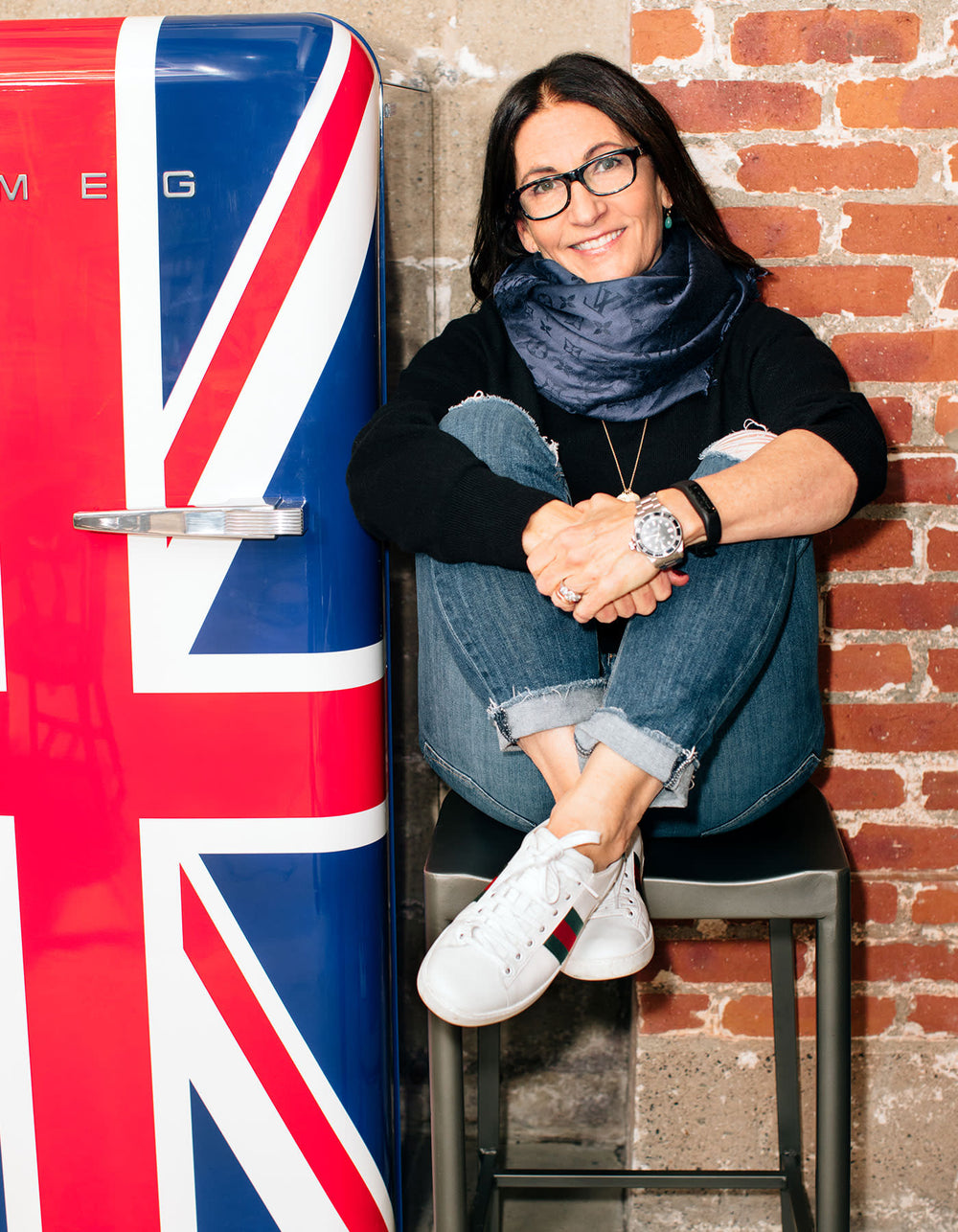Diary / Beauty / Mar 2, 2023
What Should I Apply First: Concealer or Foundation?
Written by: Piper Gray
Photography by: Ben Ritter & Jon Paterson

What Goes On First: Concealer or Foundation?
Foundation vs. concealer: which product should you apply first? You may have heard that you should apply concealer before foundation, but then again, you’ve also probably heard that foundation goes first, too. Luckily, we’re here to demystify the process and clear up any confusion. The short of it? The order in which you apply depends on how much coverage and correction you’re looking for.
The Differences Between Concealer and Foundation
When applied right, both foundation and concealer go hand-in-hand to give you a seamless complexion that lets your natural beauty shine through. And they compliment each other, working in tandem to flatter and enhance your skin tone.
You’ve probably been using these two key items in your makeup bag to set the stage of your everyday makeup look for years now, but here’s a refresher on what’s what and how they’re different.
Concealer specifically conceals and targets areas that could use a little more correction and coverage—say, blemishes, scarring, undereye circles, or other issues of discoloration. And foundation is meant to serve as a base (or a foundation) to even out your tone and provide a clean palette for the rest of your makeup.
Most professionals, the Jones Road Beauty team included, vote to put on foundation first, but there are some instances in which you should apply concealer first. But before you even strategize what you should do when you’re getting ready, it’s important to pick the right product for each. Consider your concerns. Is redness an issue? Do you have undereye circles? Or do you simply want a throw-on-and-go level of coverage?

When to Apply Foundation First
As we’ve said, foundation is a base and, when applied evenly, a seamless layer of foundation can act as a canvas for the rest of your products. With that in mind, foundation is usually what goes first, before concealer.
You may find that once you apply and evenly build up your foundation, this gives you the right amount of coverage you're looking for, and may eliminate some, or all, of the need for additional coverage in the form of a concealer. So even if you have major concerns around discoloration and other imperfections, don’t reach for the concealer just yet.
Plus putting on concealer first could unintentionally lead to some concerns. If you apply concealer before foundation, it’s likely you’ll have to reapply your concealer because putting foundation on top may accidentally move the product around, transferring it to areas that don’t need it. Not only does this unintentionally waste your product, but putting on concealer before foundation can lead to cakiness and unevenness, which will undo all your efforts toward a natural look. The more layers of coverage you introduce into your routine, the more you risk having a heavy, visible base, which is likely to draw more attention to the areas you’re trying to distract from. And no one wants their makeup to look like it’s sitting on top of your skin.
It’s important to start light with your coverage, and build if you need to. What The Foundation is ideal for that. It's a tinted moisture balm meets traditional foundation that blends seamlessly into the skin—best applied with your fingers, The Skin Brush, or The Everything Brush.

Choosing the Right Foundation Type and Shade
Even more important than figuring out when to apply your foundation is selecting the best shade that will blend seamlessly into your skin. We know picking a color can be daunting, especially if you have some concerns around undereye circles or redness, and it can be confusing when the colors you see on a swatch or packaging don't always match with what you had hoped. But there's basically one rule you should follow. You'll want to seek out a color that looks like your skin—to look the most natural, you shouldn't be able to tell that you're even wearing anything.
We start with our own What the Foundation (WTF), a tinted moisture balm meets traditional foundation that blends seamlessly into the skin, leaving you with an even, fresh complexion that looks like your skin on its best day. WTF comes in 12 shades, and we created a quiz to help you find the right shade to complement your skin tone—just answer a few questions about how you’d describe your skin tone and concerns, and we’ll recommend a shade that you can be confident in.
And there are several types of foundations, too, by formula. Here’s a breakdown of some of the more popular types of foundations to help steer you in the right direction.
-Liquid foundation: A liquid foundation is especially great if you want to cover most of your face. Start light for sheer coverage and add layers for medium to full coverage.
-Cream foundation: A heavier formulation, cream foundation is also how it sounds. This is good for fuller coverage and to help smooth out signs of mature skin.
-Powder foundation: Use a light hand with this one for light coverage. Powders can settle into fine lines so those with oily skin will enjoy this for its mattifying properties, too.
-Tinted moisturizer: Tinted moisturizer provides light coverage so if you’re looking for something with more coverage potential, this may not be the product for you. We love tinted moisturizers for how they can add a healthy glow to the skin.
-BB Cream: Similar to tinted moisturizers in terms of the amount of coverage and glow they provide, BB creams are also smooth to apply, providing a little moisturizing along the way.. (BB stands for “beauty balm” or “blemish balm.”)
-CC Cream: The CC stands for “color correcting”, and these tend to offer lighter coverage than its sister product, BB cream, while still seamlessly evening out your skin tone.
When to Apply Concealer First
While we vote to apply foundation first, there are definitely some reasons why it’s a good idea to reach for the concealer before anything else. (We also vote to experiment and improvise, too—everyone’s skin is different, as are the products best-suited to your skin, so play around and see how you can create an optimal routine for you.)
First, if you are concealing blemishes and you worry your foundation and concealer may not match up shade-wise (for example, if your concealer is much, much lighter), consider putting concealer on these problem areas first. This will help resolve some of those problem areas, especially if your product tones aren’t in line; then simply apply foundation as needed.
And if undereye circles are an issue you’re working with, applying a color-correcting concealer first to give your foundation a boost of brightness.

Choosing the Right Concealer
Like when it comes to selecting your foundation, choosing the right tone of concealer is also important for a natural finish.
We’re fans of The Face Pencil for its corrective properties and its easy glide. We recommend having a lighter shade to brighten any undereye darkness, and then a second, skin-toned shade that blends into your cheeks for even coverage.
Choosing the best colors for you upfront will help you avoid having to apply too much product. (You also won't have to worry about any creasing or cakey looks that usually accompany a heavy-handed application.)
Concealer formulations run the gamut, too—and depending on the level of correction you’re seeking, the more solid or creamier the texture, the fuller the coverage.
How to Apply Concealer and Foundation Together for a Clean, Natural Look
First things first, start with a clean face that you’ve moisturized and primed. These steps upfront prep your skin to accept your incoming foundation and concealer and ensure an undetectably flawless look.
Starting with the foundation of your choice, we recommend tackling any areas that you especially want to cover up or correct first, but go lightly and slowly. (And the tool you use depends on your foundation formulation. This may take some trial and error on your end to figure out what goes best with your preferred foundation—so you may very likely want to use a brush with one product, or a sponge with another.) Watch as the coverage takes hold so you can identify areas that may benefit from more foundation, and build accordingly.
Foundation isn’t meant to perfectly correct, so don’t forget that a concealer can take care of the remaining issues—discoloration, blemishes, etc.—that are still visible. At this point, you shouldn’t have to apply much concealer; you should already see meaningful improvement if you opted for the right shade of foundation. Focus on any remaining areas that need more correction, and blend as needed.
Now we can put the debate about when to apply concealer or foundation to rest, and hopefully you have a better idea about selecting the shades and formulas that work with your complexion to provide your desired amount of coverage and correction. So which comes first: concealer or foundation? That’s your call.













































 Miracle Balm
Miracle Balm
 Just Enough Tinted Moisturizer
Just Enough Tinted Moisturizer
 What The Foundation
What The Foundation














